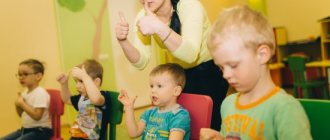Socialization is very important for children with Down syndrome, and speech plays a big role in this process. Problems may lie in the length of time it takes to accumulate vocabulary, children understand words much faster than they pronounce them, speech may not be very intelligible with distorted pronunciation of sounds, and there may also be problems with articulation and phonetics. Speech therapists should work with this, as well as parents, who should learn speech therapy techniques. In developing speech, the main thing is to be patient and talk a lot with children, correcting their mistakes. Patience and perseverance should lead to improved speech so much that the child will be able to express his thoughts without problems and communicate freely with peers. Correct speech will help you make new acquaintances and open up new horizons in learning and professional growth.
Tasks
Objectives of speech therapy work:
- a dictionary must be formed that will include basic concepts that are often used in communication;
- attention and auditory perception should develop to a level at which communication becomes effortless, the child will not need to think for a long time about what he heard and how he should express his thoughts;
- improved pronunciation, increased clarity of conversation;
- development of articulatory muscles;
- improvement of visual perception and visual memory allows you to better describe from memory the object or phenomenon you saw;
- memory development will allow you to better replenish your vocabulary, short-term memory helps in the perception of long sentences;
- the development of fine motor skills of the hands will expand the child’s range of movements, which has a positive effect on speech development;
- to increase the clarity of speech, you can adjust the structure of syllables in a word;
- training in sound analysis;
- improving coherent speech.
To implement these tasks, you must first perform a speech diagnosis and listen to the child. At the second stage, the information received must be compared with modern speech therapy techniques. The speech therapist can make a decision on how the child will learn independently, or consult with other doctors if options for eliminating the problem are possible. The next stage involves the implementation of the assigned tasks, during which it is necessary to record the dynamics of speech development.
It must be remembered that a child can improve any skill through repeated repetition and systematic practice. You can strive for the child to receive the same level of development as ordinary children, but a more correct tactic would be work that in the long term will help the child surpass his peers who do not have Down syndrome. If you try to improve the average statistical indicators on individual children, then some things may turn out worse, and some abilities may well develop much better than in ordinary children. To identify factors that will help a child achieve success, at the first stage you need to try to work in different directions - the development of oral, written speech, sound perception, and other skills.
Diagnostics
There is a diagnostic standard for identifying Down syndrome:
- A biochemical blood test designed to show the level of β-hCG, as well as AFP (a hormone produced by the fetal liver), and free estriol. A decrease in AFP levels may indicate the presence of Down syndrome in the fetus.
- Ultrasound. It is carried out three times during pregnancy - at a short term, in the second and third trimester. The first study allows us to assess pathologies in fetal development and determine the thickness of the collar zone (it should not exceed 3 mm). on the second ultrasound, you can determine the heart defect, which often accompanies Down syndrome, various pathologies in the development of the brain and spinal cord and other organs. The third study reveals smaller concomitant pathologies.
- Amniocentesis (examination of amniotic fluid). Typically performed around 18 weeks. Allows you to confirm or refute the presence of pathology with high accuracy.
Sound pronunciation
Development of sound pronunciation and perception, this stage includes the development of attention, the formation of clear pronunciation, and increased attentiveness. Visual memory improves through the use of visual aids.
First you need to work on the sounds that come out better, then you need to move on to more problematic areas of speech. First you need to practice open syllables, then work with words that will form small sentences of up to five words. Speech therapy training in its stages is similar to teaching reading to a first-grader.
You need to do articulatory gymnastics, repeating (or trying to repeat) sounds that are difficult to pronounce over a certain period of time. Of course, it is better to conduct such classes in the form of rhymes or tongue twisters, in which attention is concentrated on one sound.
You can also do breathing exercises, but not so much for the effectiveness of training, but for relaxation, because the respiratory organs and sound pronunciation are subjected to increased stress during training. Breathing exercises can be done in the form of games, for example, blowing on rotating blades, or organizing competitions to see who can bring a ball or ball from one end of the table to the other to the other the fastest. You can also blow soap bubbles - who will have more bubbles, or who will have a larger bubble.
You can also do finger gymnastics, because it is accompanied by rhymes and games. In addition to articulation, finger gymnastics is also accompanied by the development of fine motor skills. There is no need to concentrate too much time on finger exercises, because they can easily be replaced by more practical activities - for example, making dumplings, sewing, embroidery, even if it is a simple activity, but with a practical result. And having a result is the best motivation for both the child and the parents.
Conversational skills
Children may have weak short-term memory, and they do not understand long sentences and phrases very well. But this can be fixed; we need to work on developing our understanding of spoken language. It is better to do this by memorizing short phrases that need to be gradually turned into short poems. Memory in children with Down syndrome can develop quite well, and this should be used to improve speech perception.
Vocabulary without reading skills can be expanded through descriptive lessons, in which the child needs to tell a lot, confirming his words with illustrations, visual aids, or simply objects discussed in the lesson. It is advisable to conduct part of the lessons on the street; you can talk about everything that comes across on the road, pointing to the named objects. Housework, such as cooking, can also be commented on.
Such seemingly simple activities in a relaxed atmosphere have a very great effect, because it is much more interesting for a child to communicate with a loved one than, for example, to watch a themed cartoon or a children's program on a TV or computer screen. The baby will try to ask something, and this will develop his thinking and language. Vocabulary will not only be replenished, but also used immediately; intensive lessons conducted in a practical atmosphere (for example, communication while cleaning the house) do not cause fatigue and provide a positive educational effect that will influence the child’s entire life.
After learning to perceive information, you need to teach the child to reproduce it - you need to teach children to tell what is shown in the picture. First, you can take pictures with individual objects, groups of objects, then you can go on to describe the home environment from the picture, or simply describe what is in the classroom or room. The most difficult thing is to describe industrial landscapes, for example a city street, where there are many cars, shops, people, and buildings. Describing ordinary, natural landscapes is a simpler task, so it is better for the child to draw and describe all the elements of the drawing himself.
The next stage of learning is communication in the form of dialogue. At first, you can simply communicate on the question-answer principle. Then dialogue communication can be reproduced in the form of small scenes and performances. The main thing is that it is not for show for adults. There may be spectators, of course, but it should be interesting for children.
Speech development in children with Down syndrome
Angelina Kalinina
Speech development in children with Down syndrome
How to develop speech in a child with Down syndrome ?
children’s inappropriate behavior . And the point here is not at all in the crisis of three years, but in the fact that the child, unlike his peers, cannot express himself in words, he is offended and bitter that he is not understood, he cannot be a full participant in the communication process. Our task, as parents and teachers, is to help the child master intelligible, intelligible, literate speech. As practice shows, three years is the optimal age to begin teaching correct speech to children with Down syndrome .
Now it would be appropriate to characterize in general terms the speech of children with diabetes and say that almost all of them have defects in sound pronunciation, agrammatism and a poor vocabulary.
For a child with Down syndrome, learning to communicate is of great importance. With a relatively good understanding of the words addressed to him, the child has a significant lag in spoken language . The speech of children with Down syndrome is influenced by the features of the anatomical structure of the speech apparatus, neurophysiological and medical factors, and features of the cognitive sphere. All this creates additional difficulties in the formation of clear sound pronunciation and is reflected in the characteristics of voice and speech . Children with Down syndrome are so different in their speech development because Down syndrome is not a speech therapy diagnosis, but a set of different symptoms, including speech. With Down syndrome, we can encounter such speech diagnoses as:
1) systemic underdevelopment of speech caused by reduced intelligence;
2) general underdevelopment of speech caused by dysarthria, alalia, mental retardation, stuttering, and pedagogical neglect.
In Down syndrome, both dysarthria and apraxia occur, and more often, a combination of both.
Dysarthria is a condition in which the proper functioning of articulatory muscles is difficult.
Apraxia is a condition in which a child has difficulty programming, planning, and ordering sounds in speech . Dysarthria and apraxia can be attributed to neurological factors of speech difficulties in children with Down syndrome . However, specialists and parents often do not take into account that the cause of a child’s speech difficulties, lack of speech or its late onset is not dysarthria at all, but apraxia of speech . Simply put, the reason is not in the mouth, but in the head.
There are also anatomical factors:
- a high, narrow arched palate, so sounds are sometimes more “nasal”
;
- features of teething: teeth appear later, usually not in the same order as in ordinary children ; some teeth may never grow in and others may grow too crowded; this affects articulation;
- open bite, upper and lower teeth do not come together;
- small, narrower than usual upper jaw;
- relatively large tongue. It is now believed that people with Down syndrome have the same size tongue as everyone else, but due to the smaller size of the oral cavity (and due to hypotonicity)
it may not fit well in the mouth and articulation may be difficult.
How to develop speech in a child with Down syndrome ?
The main attention should be paid to training and strengthening the muscles of the lips, tongue, soft palate, and gaining speech breathing skills. By working with your child against a backdrop of intense emotions, you can compensate for the natural defects of a child with Down syndrome and improve the quality of spoken words.
Babbling is a fundamental skill for speech development ; it strengthens the mechanisms of articulation and makes them mobile. Babbling also carries out an auditory feedback reaction, i.e. the child gets used to sounds and their variations in human speech . The fact that children with Down syndrome babble less , according to scientists, has two reasons. The first is associated with the general hypotonicity inherent in these children (weakness of the muscles, which extends to the speech apparatus; the other is due to auditory feedback. Usually babies like to listen to their own babble. Due to the physiological characteristics of the structure of the hearing aid, as well as frequent ear infections, children with the syndrome Downs hardly hear their own voice. This prevents the training of individual sounds and their inclusion in words. Therefore, early diagnosis of hearing impairment has a strategic effect for the further speech and mental development of the child .
The following exercises help stimulate auditory feedback. Make eye contact with the child (distance 20-25 cm, talk to him: say “ah”
,
“ma-ma”
,
“pa-pa”,
etc. Smile, nod, encourage the child to be attentive.
Then pause to give him a chance to react. Try to conduct a dialogue with him, during which you and the child exchange reactions. Be proactive. When a child babbles, do not interrupt him, but support him by maintaining contact with him. When he stops, repeat the sounds after him and try to “talk”
him again. Vary your voice. Experiment with tone and volume. Find out what your child responds to best.
Such exercises should be carried out several times a day for 5 minutes. This technique can also be used when looking at objects or pictures. It is necessary to encourage the child to touch them. Pointing with the index finger is a result of more advanced development . The main goal is to encourage the child to babble. Name objects and pictures, encourage him to repeat individual sounds after you.
The next step after babbling is the development of articulate speech . If babbling does not spontaneously turn into speech, then the task of parents and educators is to form it. Imitation or imitation plays a big role in this. As practice shows, children with Down syndrome do not imitate spontaneously. The child must be taught to observe and respond to what he sees and hears. Learning to imitate is the key to further learning.
The development of imitation abilities begins with imitation of the simple actions of an adult. To do this, sit your child at a table or in a high chair. Sit opposite him. Make sure there is eye contact between you. Say, “Knock on the table!”
Demonstrate the action and say it in a certain way
. If the child reacts, even weakly (perhaps at first with only one hand), rejoice, praise him and repeat the exercise two more times. If the child does not react, take him by the hands, show him how to knock, and say: “Knock, knock.” knock"
. When the child masters this, you can use other movements, for example, stamping your feet, waving your arms, etc. As
develop , the basic exercises can be supplemented with finger games with simple rhymes. The same movement should not be repeated more than three times times, as the baby may get bored with it. It is better to return to the exercises several times during the day. This rule applies to all subsequent tasks.
To stimulate the imitation of speech sounds, you can perform the following exercises. Look at the child. Pat yourself on the open mouth, to make the sound “wa-wa-wa”
. Tap your hand on your child's lips to encourage him to make the same sound. To further demonstrate, bring his hand to your lips. Build the skill by tapping your child's mouth and making a sound. The repetition of vowel sounds A, I, O, U is facilitated by imitation of motor reactions.
Sound A. Place your index finger on your chin, lower your lower jaw and say: “A”
.
Sound I. Say "I"
, stretching the corners of your mouth to the sides with your fingers.
Sound O. Say a short, clear sound “O”
.
Make an "O"
with your middle and thumb when making this sound.
Sound U. Say a long exaggerated “U”
, curling your hand into a tube and bringing it to your mouth, and move it away when pronouncing a sound.
Don't forget to praise your child every time. Sometimes it may take several days before it starts to work out. If your baby doesn't repeat, don't force him. Move on to something else. Combine speech imitation with another imitation that your child enjoys.
Proper breathing has a great influence on the quality of your voice. In children with Down syndrome, breathing is shallow and occurs primarily through the mouth, since frequent colds make it difficult to breathe through the nose. In addition, a large, flaccid, hypotonic tongue does not fit in the oral cavity. Therefore, in addition to preventing colds, it is necessary to train the child to close his mouth and breathe through his nose. To do this, the child’s lips are brought together with a light touch, so that he closes his mouth and breathes through his nose for a while. By pressing the index finger on the area between the upper lip and nose, the opposite reaction is achieved - opening the mouth. These exercises can be performed several times a day, depending on the situation. It is also advisable to introduce children with Down syndrome to the jaw-forming pacifier early. When sucking, the baby's mouth will be closed and breathing will be through the nose, even when he is tired or sleeping.
The production of a good air stream is facilitated by air-blowing exercises, which also rely on the child’s ability to imitate. The tasks are completed in a relaxed playful manner. Any efforts of the child should be supported until he begins to do it correctly. For example: blowing on hanging feathers or other light objects; play the harmonica, making sounds when inhaling and exhaling; blow away feathers, cotton wool, torn tissues, table tennis balls; blow out a match or candle fire; play toy trumpets and flutes, blow on wind wheels; inflate rolled up paper snakes and balloons; blow through a straw into soapy water and blow bubbles; set paper boats and floating toys in the form of animals in motion by blowing air; blow through a tube and thereby set feathers and pieces of cotton in motion; blow soap bubbles; exhale loudly or growl; blow on a mirror or glass and draw something there. These and other exercises can vary in different play forms according to the age of the child.
are especially important for children with Down syndrome , since normal tongue motility is a good prerequisite for proper sucking, swallowing and chewing, as well as speaking. Exercises to develop tongue and jaw mobility consist primarily of massage and assistance in getting used to age-appropriate foods.
When massaging the tongue, the edges of the tongue are alternately pressed on the left and right with the index fingers until a reverse reaction occurs. The pace of change depends on the speed of the response. With careful movements of your index finger, you can move the tip of your tongue to the right and left, up and down. Similar movements are caused by light tickling with a drinking straw or toothbrush. Gently brushing the edges of the tongue with an electric toothbrush can sometimes be helpful. The small brushes from the teeth brushing training kit are also suitable. By unilaterally vibrating one cheek and pressing on the other, you can cause a rotational movement of the tongue in the mouth.
Examples of exercises for developing tongue mobility :
• lick spoons (with honey, pudding, etc.)
;
• smear honey or jam on the upper or lower lip, left or right corner of the mouth so that the child licks with the tip of his tongue;
• make movements of the tongue in the mouth, for example, alternately placing the tongue behind the right or left cheek, under the upper or lower lip, flicking the tongue, brushing the teeth with the tongue;
• click your tongue loudly (while keeping your tongue behind your teeth)
;
• grab a plastic cup with your teeth, put buttons or balls in it and, shaking your head, make noise with them;
• fasten the button to a long rope and move it from side to side with your teeth.
Exercises for developing jaw and tongue mobility are included in articulation games that imitate various sounds or actions (a cat licks its lips, a dog bares its teeth and growls, a hare gnaws a carrot, etc.).
Modified lips in children with Down syndrome are associated with constant flow of saliva and pressure of the tongue, especially on the lower lip. Therefore, it is important to teach your child to close his mouth. It is necessary to pay attention to the fact that the lips close freely, the red border of the lips remains visible and the lips are not retracted. Infants and small children can be stroked with the middle and index fingers to the left and right of the nose downwards, thus bringing the raised upper lip closer to the lower lip. The lower lip can be brought closer to the upper lip with light pressure from the thumb. In this case, the chin should not be raised, because then the lower lip will overlap the upper. Protrusion and stretching of the lips, alternate overlapping of one lip over the other, twitching and vibration of the upper lip develop their mobility . To strengthen muscles, you can let your child hold light objects with his lips (straws, send air kisses, hold a spoon in his mouth after eating and squeeze it tightly with his lips.
General hypotonia in children with Down syndrome entails reduced mobility of the velum palatine, which is expressed in nasal and hoarseness of the voice. Gymnastics for the palate can be combined with simple movements: “aha”
- arms rise upward in a sweeping manner,
“ahu”
- clap hands on the thighs,
“ahai”
- clap hands,
“aho”
- stomp one foot hard.
The same exercises are carried out with the sounds “p”
,
“t”
,
“k”
.
Training the velum is facilitated by playing with a ball with shouting out individual sounds: “aa”
,
“ao”
,
“apa”
, etc. It is useful to demonstrate natural sounds
(coughing, laughing, snorting, sneezing)
and motivating the child’s imitation. You can use game exercises to repeat: inhale and exhale on
“m”
;
speak the syllables “mama”
,
“me-meme”
,
“amamam”,
etc.;
breathe on a mirror, glass or into your hand; exhale with the position of the speech apparatus as with the sound “a”
;
exhale through the narrow gap between the upper teeth and lower lip; place the tip of the tongue on the upper lip and phonate, then on the teeth and on the bottom of the oral cavity; pronounce the sound “n”
with your nose pinched;
when exhaling, move from “p”
to
“t”
.
Whispering is good training.
The development of spoken language is facilitated by the situational use of words. You should name those items that are most relevant to your child. For example, if a child wants a cookie, then, pointing to it, you need to ask: “Cookies?”
and answer:
“Yes, these are cookies
. You must use a minimum number of words, speak slowly and clearly, and repeat the same word several times. It is desirable that the articulatory movements of the adult’s lips fall into the child’s field of vision and evoke a desire to imitate them.
Many children with Down syndrome use gestures and movements to replace words. This should be supported and helped them communicate at this level because realizing the meaning of each gesture through words activates spoken language. In addition, gestures can be useful as a supplement to speech in moments when a child finds it difficult to convey his message in words.
Due to the fact that the pronunciation side of the speech of children with Down syndrome can be improved throughout life, many of listed above can be continued to be done even when the child has already learned to speak.
Writing and reading
The final stage of speech training is learning to read and then write. Of course, it is better to combine these two types of activities. You can start learning letters quite early - oddly enough, children with Down syndrome can distinguish all the letters of the alphabet already at the age of two. This once again suggests that with diligent work, children with the syndrome can in many cases be ahead in development of children who do not have a congenital disease, but also do not have such an advantage as intensive training.
Reading makes it possible to orally analyze the composition of a word, the written form of speech gives even more time to improve speech, because the process is slow, and you can repeat sounds, syllables, words many times, improving pronunciation. In the process of learning to write, one develops the ability to correlate letters and sounds, because words are often written a little differently than they are pronounced.
At this stage, the child learns to form compound words, as well as change simple ones. Not only pronunciation is developed, but the ability to insert words in the correct form based on other forms in the sentence. Also, reading and writing are a good opportunity to add difficult words to your vocabulary that are not so often found in spoken language.
Classes with a speech therapist or parent should last about half an hour every day, maybe half an hour in the morning and half an hour in the evening.
In conclusion, we can say that in order for a child to communicate correctly and effectively, he needs to communicate a lot with ordinary children. At the same time, difficulties are overcome that the child will face in one way or another all his life - misunderstanding, perhaps the reluctance of other children to make contact. Parents should take care that the child’s level of development is sufficient to attend a regular school and a regular kindergarten, because the child’s behavior is often imitative - he develops well in a team, and at the same time socialization is difficult if the circle of communication is limited to relatives or children who also have difficulty communicating.





